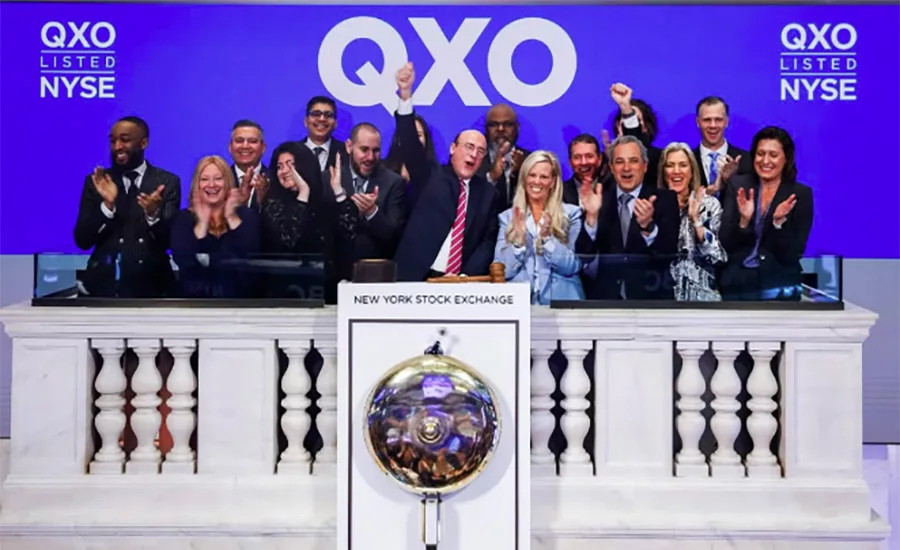Post-Deal Glow
QXO Surging From 'Outperform' Rating After Beacon Deal
Wolfe cites superior organic growth and innovations like branch automation and digital tools, but cautions that high leverage poses risks

An equity research report shows that QXO is well-positioned following the Beacon acquisition, with contractors, employees and shareholders set to become beneficiaries.
— Image courtesy of QXO via Instagram
A new report from Wolfe Research, shared with investors on Friday, provides a comprehensive analysis of QXO’s financial condition following the acquisition of Beacon, offering a generally positive outlook along with an outperform rating.
The analysis shows that QXO has assembled a strong balance sheet and impressive cash flow; however, for continued growth, it will be crucial for the company to manage integration effectively and handle elevated leverage.
Wolfe’s findings are especially important for professional roofing contractors and building supply operators, shedding light on key elements such as pricing dynamics, product availability, customer service — and the growing competitive pressures of an increasingly consolidated market.
In its note, Wolfe Research writes: “We initiate coverage of QXO with an outperform rating and a $44 price target.” Trevor Allinson, Wolfe’s lead analyst on the report, said the firm sees “superior organic EBITDA growth and a unique M&A value‐creation opportunity as QXO disrupts the building‐products distribution landscape.”
Wolfe forecasts that QXO’s EBITDA will grow at a roughly 35 percent compound annual growth rate over the next five years, “significantly outpacing peers.”
RELATED
QXO's AI-Driven Plans for the 'New' Beacon Bldg. Supply
Equity analysts cited QXO’s robust cash flow generation as a key financial strength, supporting the company’s stewardship under Chairman and CEO Brad Jacobs — whose business track record has been widely praised — believing he will drive disciplined capital allocation and debt reduction over time.
Technology integration and operational improvements are central to Wolfe’s bullish thesis.
“We expect QXO to take a tech‐forward approach to optimize pricing and procurement, automate branches, standardize shipping and handling processes, improve customer service and increase digital penetration, which should drive market‐share gains and rapid margin improvement,” Allinson stated.
In layman’s terms, this should translate into more transparent pricing, faster order fulfillment and improved online ordering tools — areas where over half of large distributors reportedly lack basic capabilities, such as inventory tracking and customer notifications.
Size is another differentiator. “Scale is key in distribution, and we expect QXO grows rapidly, both through organic growth and M&A,” Wolfe wrote.
“QXO expects to eventually approach $50 billion in revenue versus roughly $10 billion in 2025,” the note continued. “As QXO scales, the company should gain increased purchasing power while driving synergies and leveraging the increased tech.”
For roofing contractors, it means QXO could negotiate lower input costs with shingle and accessory manufacturers, potentially dampening price volatility in the turbulence of 2025 and beyond. Other building supply owners may face stiffer competition, but could also benefit from expanded product assortments and faster shipping if QXO’s branch‑network optimization is successful.
Rose-Tint Omitted
Despite the optimism, Wolfe outlined several challenges. In the report’s “Investment Concerns/Risks” section, Wolfe cautioned that M&A execution remains a pivotal risk due to high expectations for “nonorganic” value creation. QXO is currently trading at a premium to other building products and distributor peers.
The premium is likely referencing QXO’s currently high leverage. Jacobs’ tender always exceeded Beacon’s 52-week high on the Nasdaq; he wanted Beacon and paid a big-ticket price for it.
Allinson wrote, “While we believe a premium valuation is warranted given the potential for future value creation not only through M&A activity but also through organic improvement with the company’s existing roofing‑distribution business, we acknowledge the expectation for value creation embedded in the current multiple is significant.”
The heavy leverage means contractors can’t run on cruise control and should remain alert to possible service interruptions or integration issues that may temporarily impact material availability or delivery timelines.
Another point of caution Wolfe noted is QXO’s exposure to nonresidential roofing markets. Wolfe stated, “Near‑term, we would not be surprised to see QXO’s [nonresidential] end‑markets underperform given soft leading indicators, with QXO more heavily impacted by fluctuations in the commercial market than peers.”
Wolfe’s research determined that QXO has the third-highest U.S. nonresidential exposure among its coverage, at nearly 30% of revenues, more than double the group’s average of 14%.
Because interest rate drops remain stalled due to tariff instability, alongside a soft residential construction market that is dampening new home starts, roofers and general contractors don’t have a tremendous amount of runway.
As the Associated Builders and Contractors trade group has noted, new nonresidential starts have declined for 21 of the past 23 months and remain down about 18% year-over-year. Additionally, commercial reroofing is typically driven by weather patterns rather than large new builds; distribution volumes could face headwinds. The report indicated that contractors focusing on commercial work should prepare for tighter bidding environments.
General Prognosis: Bullish
Wolfe Research concluded that QXO’s combination of a seasoned management team, strong cash flow profile, and tech-infused consolidation strategy positions it favorably, especially in the roofing distribution sector.
Lilli Tillman Smith, a roofing and insulation industry analyst with Principia Consulting, described the Wolfe research as “really interesting,” calling out QXO’s clear plans for quick growth — and not by using Beacon’s playbook of expansion through acquisition — rather through gained efficiencies.
“Things like warehouse automation, better procurement, and optimizing the salesforce aren’t just buzzwords here; they’re part of a well-thought-out strategy that could drive margin improvement,” she said.
“What stands out is the leadership — Brad Jacobs has a solid track record of building value across different industries, and it looks like he’s applying the same tech-driven, data-heavy approach here,” Tillman Smith added. “The building products distribution space doesn’t usually get this kind of innovation, so QXO’s plan to modernize and consolidate could really shake things up.”
Market Reaction
Shares of QXO opened at $18.16 on Friday in heavy trading, currently 66% higher than average at the time of this writing. The stock, traded on the New York Stock Exchange, has a 12-month low of $10.61 and an outlying 52-week high of $290; the firm’s market cap stands at $10.71 billion.
Wolfe’s one-year target price of $44 is more than 140% higher than Friday’s open. Another sign of market confidence has been the influx of institutional investors.
According to QXO’s latest 13F filing with the Securities and Exchange Commission, several hedge funds and other institutional clients have recently bought and sold shares of the business.
Notable standouts include Barclays PLC, which acquired a new stake during the fourth quarter valued at $1.16 million. Pittenger & Anderson Inc. increased its holdings by 4,376.7% during the fourth quarter, as did the State of New Jersey Common Pension Fund D, which purchased a new position during the fourth quarter valued at $2.09 million. Hedge funds and other institutional investors own 58.68% of the company's stock.
QUICK READ: 5 Takeaways
- QXO Earns Bullish Rating and Ambitious Price Target: Wolfe Research initiated coverage of QXO with an "outperform" rating and a $44 price target, citing strong cash flow, superior EBITDA growth potential, and a tech-driven strategy for disrupting the building-products distribution market.
- Scale and Technology Are Central to QXO’s Strategy: The company plans to modernize operations via automation, pricing optimization, and digital tools — aiming for faster fulfillment, transparent pricing, and greater market share in a $50B revenue pursuit.
- Implications for Roofing Contractors: Contractors may benefit from improved service and pricing as QXO expands and optimizes its network. However, they should stay alert to potential short-term disruptions during integration and M&A execution.
- Risks Include Leverage and Market Exposure: Wolfe flagged high leverage and exposure to softening nonresidential markets as concerns. With commercial reroofing demand tied to weather, QXO's volume growth may face near-term pressure.
- Market Confidence Is High — For Now: Despite its recent trading volatility, QXO has attracted significant institutional interest. Investors are betting that Jacobs’ leadership and a tech-infused approach will drive value in a consolidating sector.
For roofing contractors and building‑supply operators, Wolfe’s analysis — corroborated by several financial reporting outlets Principia’s Tillman Smith — suggests the emergence of a larger, more technologically sophisticated QXO, capable of leveraging scale to lower costs and improve service.
Contractors should keep an eye on QXO’s branch expansions and tech rollouts, as they could provide faster lead times or new supply options.
Ultimately, the report underscores that in a consolidating distribution environment, scale and technology will be key to success, and QXO is wagering that its growth strategy will deliver both.
Looking for a reprint of this article?
From high-res PDFs to custom plaques, order your copy today!






.webp?height=200&t=1743707846&width=200)


